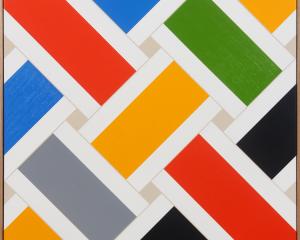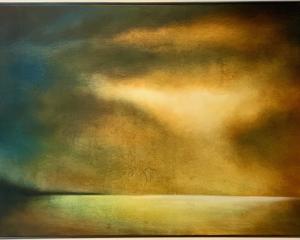James Dignan takes a look at exhibitions at the Milford Gallery, the Salisbury House Gallery, as well as new works by Kushana Bush.
"Patikitiki Connect", Peata Larkin, and "Eternally Yours", Johnny Turner, Milford Gallery.
Two intertwined exhibitions at the Milford Gallery blend traditional and modern, physical and spiritual into a satisfying whole.
Peata Larkin's work combines Maori tukutuku panel designs with the unusual method of injecting paint through dark canvas to create patterns composed of bright dots of colour.
In her latest work, this attractive approach has been taken to a logical extreme by placing these canvases over Perspex-fronted light boxes.
The result is both startling and effective.
The designs glow with spiritual warmth and it is no surprise that the concept of stained-glass windows is brought to mind.
The symbolism of starlight, already inherent in the patterns which form Larkin's inspiration, becomes more apparent in these fine pieces which well combine traditional and technological approaches.
Johnny Turner's bold sculptures bridge the gap between past and future in other ways.
These simple, strong forms are inspired by concepts of eternity, and by the idea that we are made of stuff which has existed for aeons and which has already been part of other lives, other stars.
In using the hardest of rock and shapes which imply both birds and spacecraft, the artist has created symbolic seeds, forever flying across the universe in forms that remain unchanged though generations come and go.
"Land of Rock", Rod Eales, and "Coastal Light", Manu Berry, Salisbury House Gallery.
Salisbury House Gallery also features complementary works by two artists.
Rod Eales' work focuses on the forms and structures of the Otago landscape, and features several stylised acrylic paintings.
In these, the walls of caves are used as frames within frames, allowing the emphasis to be placed on the play of light across the rugged surfaces of the stone.
The artist's less-well-known pen drawings are a revelation.
Eales has used an ink pen to create gentle, subtle landforms which effectively evoke the spirit of the land she has depicted.
The pen work is fine in many senses of the word, being both attractive and delicate, and possessed of a clear quality that would normally be more associated with etchings.
Manu Berry has also shown two sides to his skills.
A move to Wellington left the artist briefly without his printmaker's tools, but Berry occupied his time well by honing his drawing skills, here shown by a series of graphite studies of gulls.
The gentleness and delicacy of the shading is thrown into stark relief by the several large woodblock prints alongside, notably a depiction of the brooding sky above Pencarrow.
Also notable are two large Japanese-influenced scrolls on translucent mulberry paper, the undulating ink textures well suiting the rocking coastal waters that are Berry's subject matter.
"The Revival", Kushana Bush, Brett McDowell Gallery.
The term "ugly/beautiful" could have been created especially to describe Kushana Bush's art.
In a series of 12 intriguing gouache and pencil works, the artist has invoked a spirit of ancient art.
By combining elements of Indian, Japanese, and Mexican traditional styles with early medieval European art, she has created a universal tribal artform.
The muted colours and naive block figures would not be out of place unearthed at an archaeological dig.
Bush's paintings depict figures in the depths of medical despair performing ritual obeisance to an uncaring fate.
There is an air of helplessness about the figures, yet at the same time, there is a spirit of hope against all odds.
It would be impossible to call the images beautiful - figures with open sores and self-inflicted wounds abound.
Yet there is something fascinating about the pieces, and the use of stylised patterned features such as the repeated lines of grey rocks and the formalised angles of the figures imbue the compositions with a rhythmic grace.
Once the viewer gets past the initial shock of the subject matter, these pieces become surprisingly attractive works.














